|
The Hashemite Kingdom of Jordan
- Petra & the Wadi Rum, Jordan
Greetings again and we hope this email finds everyone
safe and sound. We want to first send our prayers
to Turkey in the aftermath of the devastating
earthquake. Our friend in Istanbul, Attila, emailed
us to let us know that he was fine from the first major quake, but
one of the larger aftershocks brought the second story of his shop
crashing down, destroying much of it and breaking his cousin's arm. So much work
now has to be done to rebuild their shattered lives.
When we last left off, we were in Jerusalem.
From Israel, we traveled to Jordan, a desert kingdom
established in the 1920's after the land was given as
a gift from the British to King Abdullah in return
for Arab support. After his assassination, the young
King Hussein came to power and has ruled for the last
fifty years til his death last year from cancer. Some
may also know of his wife, Queen Noor, the former
Lisa Hallaby of New York. Now Jordan is ruled by his
son King Abdullah II. What we saw greatly surprised
us.
We didn't really now what to expect, but Jordan is a
modern kingdom trying to move into the future. The
country is mostly desert, and unfortunately has no
oil, making it relatively poor nation. However, their
cities have almost first world infrastructure and the
people are incredibly hospitable and friendly.
When we first arrived in Amman, as we were struggling across the
intensely hot cityscape, a local Bottled Water Supplier saw us through
his window and invited us in for ice cold water. Then he offered us
valuable info about the city and was generally a really nice guy.
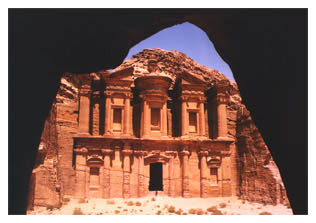
Our main destination in Jordan was Petra, the famous
hidden city. Made famous by Indiana Jones and the
Last
Crusade - remember the scene near the end, as they
travel to find the Holy Grail, and after riding
through
an incredibly narrow valley come upon a fantastic
rock building that they then enter to find the grail.
Well, that is one small part of Petra. Built in the
6th century BC by the Nabateans, their buildings were
carved directly from the rock walls themselves. Hidden
for almost two thousand years, its location was not
known to anyone except the Beduoin, desert people who
lived in the area. In 1870, a British explorer
tricked
them into showing him the famous lost city and now,
it is truly one of the modern wonders of the world
and
much visited by travelers everywhere.
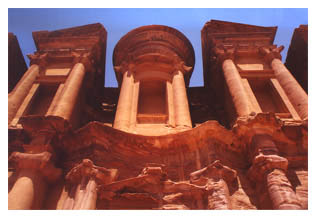
To get to Petra, we first rode in the converted trunk
of a beat-up station wagon. They had put seats into
the
trunk, but we were about 8 inches higher than
everyone
else, and had to sit hunched over for a five hour
ride through the desert. Oh and the spare engine
behind
our head didn't help the comfort level. On the trip,
we saw almost no other cars, and besides one reststop,
no other buildings. Just rolling sand dunes and
desert
scapes and a hot breeze blowing through the window
to stay somewhat cool. But once there, it was worth
it.
We stayed in a hotel, a ways away from the ruins. They have an
interesting all-you-can-eat dinner , even if there are only a few guests
in the hotel, as it was with us. Seems, this is de rigour for all the
hotels in the area.
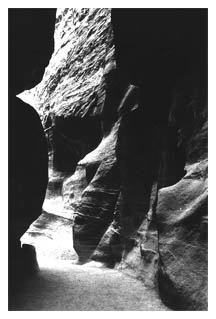 The
entry to the valley is near the end of the town. From there, it is two
mile hike through a narrow gorge to get to the hidden city. Donkeys tied
to posts outside the ticket office beckon the lazy the unfit. Come and
ride to the hidden city, but we chose our own to feet and set off. The
gorge walls climb high on either side and the smooth stone reveal layers
upon layers of history. The
entry to the valley is near the end of the town. From there, it is two
mile hike through a narrow gorge to get to the hidden city. Donkeys tied
to posts outside the ticket office beckon the lazy the unfit. Come and
ride to the hidden city, but we chose our own to feet and set off. The
gorge walls climb high on either side and the smooth stone reveal layers
upon layers of history.
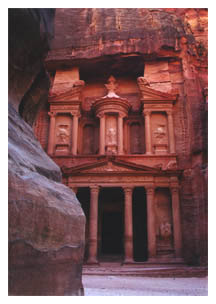 The
Treasury Building as it suddenly appears The
Treasury Building as it suddenly appears
There
it is, around a tight bend. The
sunlight penetrating the gorge painted the stone a marvelous pink. The
famous Treasury building stood tall and proud. But it is not the only
one. Similar structures are dotted throughout the entire valley, incredibly intricate
carved facades with
sculpture and decoration to rival the Romans.
We started out at
six
in the morning to avoid the heat and try to see as
much
as possible. It is in the outlaying areas where some of the more
spectacular buildings are. But ever present in the main square are
donkeys ready to ferry people up to the remoter locations. Some
locations are an hour's hike straight up stone staircases, but the sites
are well worth the effort. But a note of caution, you have to dodge
donkey doo all the way up...
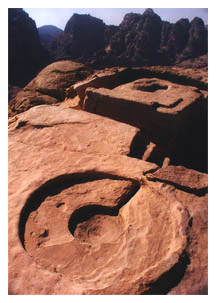
Some of the hikes were pretty difficult, climbing old
rock hewn stairs, some steps, the height of three
normal
stairs at home. One place, known as the High Place of
Sacrifice, was an hour and a half climb to the top,
but once there, we looked over the entire valley next
to a huge alter with a drain carved in the rock for
the
blood to run down the mountain.
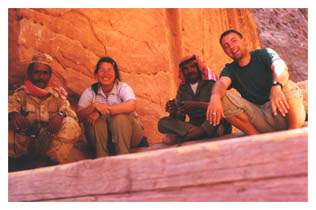
During one of our more solitary hikes, we came
upon a Beduoin man, who lived there. He spoke some
English and we sat and talked for awhile. He took us
to
the top of a mountain peak and pointed out the whole
valley. Afterwards, a very great honor, he made tea
for
us.
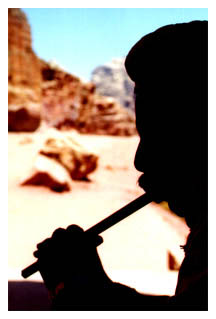 The
Pied Piper of Petra The
Pied Piper of Petra
As we sat drinking it, his friend joined us and
played delightful Beduoin music on a tin pipe with
some holes punched in it. Talking with him for
awhile,
his life is so facinating. He was born in the valley
and has lived their all his life. He has four wives,
part of the culture, and ten children (so far.) He
asked Doug how many wives he had and if he would like some more. And as a parting gift, he gave us an ancient Nabatean
coin that the Beduoin find all over the valley. It is
almost 2500 years old. What a gift. All we gave him
was a sketch that Ann made of him sitting in the
valley. All said, it is not to be missed in the
Middle
East.
Our other destination was the
Wadi Rum, a fantastic
desert valley filled with unbelievable mountains. The
Wadi Rum was made famous by T.E. Lawrence of the British Army, who so fell in love with the area and
the Beduoin, he left 'civilization' to live in the
desert and help them create their own country, which
directly led to the establishment of Jordan. The
Wadi Rum itself, was made famous as the actual
setting
and film location of Lawrence of Arabia. The Wadi Rum
is an area of about 150 miles within a must larger
desert, but the area is so famous for the rock
formations found nowhere else in the world.
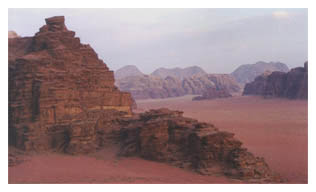
To actually visit the
Wadi Rum, we, along with two
crazy Israelis hired a Beduoin man and his Toyota
Land
Cruiser. The vehicle, similar to a pick-up, with
seats
in the back, was like our guide, Ibrihim. Rough
around
the edges, but very dependable. Our group dynamics
were hilarious. Ibrihim, our guide spoke Arabic and
almost no English. Mustafa, our Arab Israeli friend spoke
Arabic and Hebrew. Benny our other Israeli friend
spoke Hebrew and English, and of course, us only
English. So to actually ask Ibrihim a question it had
to go through four people and back to get an answer.
And it frustrated us to no end, when a simple question went through the
ranks, through various incarnations, much hand waving, lots of words,
and then finally the answer would reach us as a simple yes or a no!
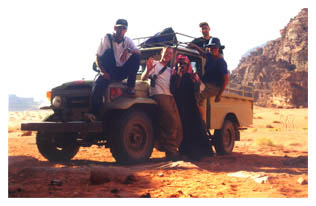
Mustafa,
Benny, Ibrihim, Doug and Ann
After morning tea, we
set off with provisions (canned goods for lunch and
a big container of water-can never have too much in
the desert!) The Land Cruiser just flew over the
sand, we thought for sure, some of the dunes, it
would
get stuck, but Ibrihim managed to get us over every
time. We sat in the back on the seats, and just hung
on for dear life. First he showed us rock carvings that date back
to prehistoric man. Exposed to the elements and receiving almost no
attention, the figures danced over the rocks much as the Beduoin people
still do today.

We then visited the remains of Lawrence's house and his precious spring of fresh water.
The formations are also home to a number of precarious rock bridges,
formed over thousands of years of geological activity. We visited one
such bridge, a thin slab of rock 30 feet in the air that spanned a large
crevasse. We shimmied and climbed our
way up to sit and dangle our feet over the edge.
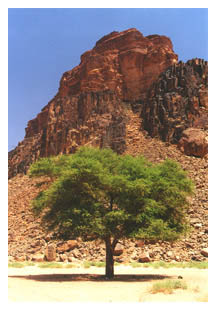 Oasis... Oasis...
Flying
over the desert, we saw nothing but sand and red rock for miles. Then it
appeared like a mirage. That one green tree, the only bit of green we
had seen all day. Ibrihim stopped nearby to take shade among the rocks,
but we thought the tree looked so much more inviting. I walked quickly
toward, when the buzzing began. It started softly and grew louder til it
became a roar in my ear. I realized that the tree was harboring a vast
colony of hornets attracted to its leafy cool wonders. I figured they
got there first and I wasn't gonna barge in.
When we stopped for lunch, we realized we had no can
opener for our hummos. No problem, Ibrihim, ever the
resourceful Beduoin, pulled out his trusty dagger and
sliced open the cans easy peasy. Then he took out a
small teapot, built a fire and made tea for us all.
Its a hundred degrees, and he has to have his tea.
Well, to finish the day, we climbed another rock
formation and watched the sunset, painting the desert
in shades of orange and fiery red. Breathtakingly sublime.
So, for our short time in Jordan, we saw and did so
much and were so impressed by small country that has done so much
with so little.
Ten four good buddies
ann and doug
index | back
| next |
